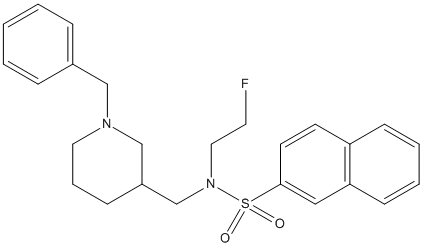5DYW-5hf-F
General
Type : Piperidine,Derivative of Donepezil,Sulfur Compound,Sulfonamide,PET probe
Chemical_Nomenclature :
Canonical SMILES : C1=CC=CC(=C1)CN2CCCC(C2)CN(CCF)[S](=O)(=O)C3=CC4=C(C=C3)C=CC=C4
InChI : InChI=1S\/C25H29FN2O2S\/c26-14-16-28(31(29,30)25-13-12-23-10-4-5-11-24(23)17-25)20-22-9-6-15-27(19-22)18-21-7-2-1-3-8-21\/h1-5,7-8,10-13,17,22H,6,9,14-16,18-20H2
InChIKey : OMFDZXMFIWQFRJ-UHFFFAOYSA-N
Other name(s) : 5hf-F
MW : 440.57
Formula : C25H29FN2O2S
CAS_number :
PubChem :
UniChem : OMFDZXMFIWQFRJ-UHFFFAOYSA-N
IUPHAR :
Wikipedia :

Target
References (1)
| Title : Synthesis and Initial Characterization of a Reversible, Selective (18)F-Labeled Radiotracer for Human Butyrylcholinesterase - Gentzsch_2021_Mol.Imaging.Biol__ |
| Author(s) : Gentzsch C , Chen X , Spatz P , Kosak U , Knez D , Nose N , Gobec S , Higuchi T , Decker M |
| Ref : Mol Imaging Biol , : , 2021 |
| Abstract : Gentzsch_2021_Mol.Imaging.Biol__ |
| ESTHER : Gentzsch_2021_Mol.Imaging.Biol__ |
| PubMedSearch : Gentzsch_2021_Mol.Imaging.Biol__ |
| PubMedID: 33660167 |